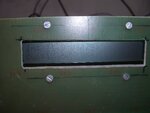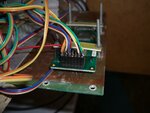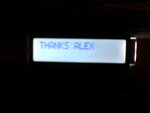#MAAM#
Full Member level 2

My greetings,
I tried to write hello word on lcd 16x2 with atmega8 and the word doesn't display. this is my code
i tried too much. the program is too simple but doesn't work. i upload also my schematic and simulation file with proteus and the source code. thanks in advance
I tried to write hello word on lcd 16x2 with atmega8 and the word doesn't display. this is my code
Code:
/*********************************************
This program was produced by the
CodeWizardAVR V1.23.8c Professional
Automatic Program Generator
© Copyright 1998-2003 HP InfoTech s.r.l.
http://www.hpinfotech.ro
e-mail:office@hpinfotech.ro
Project :
Version :
Date : 2012-05-21
Author : Abbas
Company :
Comments:
Chip type : ATmega8
Program type : Application
Clock frequency : 1,000000 MHz
Memory model : Small
External SRAM size : 0
Data Stack size : 256
*********************************************/
#include <mega8.h>
// Alphanumeric LCD Module functions
#asm
.equ __lcd_port=0x18
#endasm
#include <lcd.h>
// Standard Input/Output functions
#include <stdio.h>
// Declare your global variables here
char lcd_buffer[16];
void main(void)
{
// Declare your local variables here
// Input/Output Ports initialization
// Port B initialization
// Func0=Out Func1=Out Func2=Out Func3=Out Func4=Out Func5=Out Func6=Out Func7=Out
// State0=0 State1=0 State2=0 State3=0 State4=0 State5=0 State6=0 State7=0
PORTB=0x00;
DDRB=0xFF;
// Port C initialization
// Func0=In Func1=In Func2=In Func3=In Func4=In Func5=In Func6=In
// State0=T State1=T State2=T State3=T State4=T State5=T State6=T
PORTC=0x00;
DDRC=0x00;
// Port D initialization
// Func0=In Func1=In Func2=In Func3=In Func4=In Func5=In Func6=In Func7=In
// State0=T State1=T State2=T State3=T State4=T State5=T State6=T State7=T
PORTD=0x00;
DDRD=0x00;
// Timer/Counter 0 initialization
// Clock source: System Clock
// Clock value: Timer 0 Stopped
TCCR0=0x00;
TCNT0=0x00;
// Timer/Counter 1 initialization
// Clock source: System Clock
// Clock value: Timer 1 Stopped
// Mode: Normal top=FFFFh
// OC1A output: Discon.
// OC1B output: Discon.
// Noise Canceler: Off
// Input Capture on Falling Edge
TCCR1A=0x00;
TCCR1B=0x00;
TCNT1H=0x00;
TCNT1L=0x00;
OCR1AH=0x00;
OCR1AL=0x00;
OCR1BH=0x00;
OCR1BL=0x00;
// Timer/Counter 2 initialization
// Clock source: System Clock
// Clock value: Timer 2 Stopped
// Mode: Normal top=FFh
// OC2 output: Disconnected
ASSR=0x00;
TCCR2=0x00;
TCNT2=0x00;
OCR2=0x00;
// External Interrupt(s) initialization
// INT0: Off
// INT1: Off
GICR|=0x00;
MCUCR=0x00;
// Timer(s)/Counter(s) Interrupt(s) initialization
TIMSK=0x00;
// Analog Comparator initialization
// Analog Comparator: Off
// Analog Comparator Input Capture by Timer/Counter 1: Off
// Analog Comparator Output: Off
ACSR=0x80;
SFIOR=0x00;
// LCD module initialization
lcd_init(16);
lcd_clear();
while (1)
{
// Place your code here
lcd_gotoxy(0,0);
sprintf(lcd_buffer,"Hello");
lcd_puts(lcd_buffer);
};
}i tried too much. the program is too simple but doesn't work. i upload also my schematic and simulation file with proteus and the source code. thanks in advance





